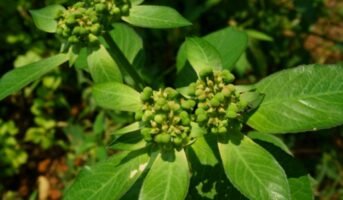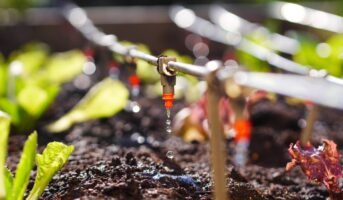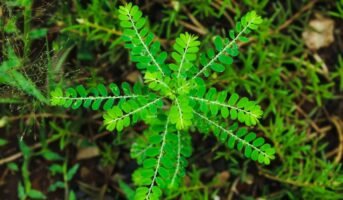Vicia faba, often known as the broad bean or faba bean in the culinary sense, is a species of vetch belonging to the pea and bean family fabaceae. It is extensively farmed as both a crop for human food and a cover crop.
Native to the Mediterranean region and southwestern Asia, broad beans are an excellent food for compact gardens since they provide great yields from very little space. The flavour of homegrown produce is significantly better than that of produce purchased in stores.
Broad Beans key facts

Source: Pinterest
| Scientific Name | Vicia faba |
| Family | fabaceae |
| Common Name | broad bean, fava bean, faba bean, horse bean, field bean, tic bean |
| Known Hazards | None known |
| Habitats | China, Ethiopia, Australia, UK, France, Egypt, Peru |
| Season | Late spring to mid-summer, October through November |
| Height | 3 to 4½ feet |
| Maintenance | Very Low |
What is Vicia Faba?
Vicia faba is a class of flowering plants or vetch, from the pea and bean family Fabaceae. The plant is widely grown as a crop for human consumption and as a cover crop to add nitrogen to the soil. It is an annual plant, which reaches a height of 0.5 to 1.8 metres, with two to four stems that are square in cross-section. The leaves of the plant are 10 to 25 centimetres in length, pinnate with 2 or 7 leaflets, and glaucous (grey-green).
What is the importance of Vicia Faba?
Vicia Faba is a popular crop and an agronomically viable alternative crop to cereal. Commonly known as broad beans, it is eaten when it is still young and tender. Thus, early harvesting is done. It is grown as a vegetable for human consumption and has many culinary uses. Moreover, some varieties known as field bean, having smaller and harder seeds, are grown for feeding livestock.
Broad Bean types
- Broad Bean ‘Aquadulce Claudia’:
An old favourite and one of the finest varieties for planting in fall.
- Broad Bean ‘Crimson Flowered:
A heritage variety of broad beans with red flowers produces an excellent edible decoration.
- Broad Bean ‘The Sutton’:
A dwarf broad bean cultivar that grows no taller than 30cm (12 inches). Ideal for containers and small areas.
- Broad Bean ‘De Monica’:
Among the earliest ripening spring-sown types.
- Broad Bean ‘Masterpiece Green Longpod’:
This high-yielding cultivar produces up to seven beans per pod.
How are broad beans eaten?

Source: Pinterest
If you cultivate your own beans, the young leaves are edible and can be prepared like spinach by steaming or wilting. In addition to that, the blooms can be used to spruce up your salads.
- You can have fresh broad beans raw or cooked. Fresh (in their pods), frozen (typically pods), canned, and dried varieties are available.
- When young (up to around 6 centimetres), broad beans are cooked and eaten in their little, tender pod. As the pod grows in size, it gets tough.
- Older, longer broad beans have a more robust husk/pod and a light green shell around the beans, although they may be eaten whole or mashed.
- Make a fantastic spread for toast or use it as a vegetable dip by mashing your cooked broad beans.
- Keep the broad bean pods whole for use in risotto, pasta, or as a side dish.
- Famous fava / broad bean recipes include Ful Medames (an Egyptian stew), Falafel (a Middle Eastern classic), and Maltese Kuksku soup.
Instructions to grow broad neans

Source: Pinterest
You should cultivate your broad beans in full light and on soil that is rich, fertile, and has been well-manured. Find a place that is out of the path of any severe winds and position yourself there. Broad beans are most successful when grown on hills, although they can be grown in practically any soil as long as the pH range is between 6.5 and 7.5. To avoid the seeds decaying in the ground due to the heavy clay content or high moisture content of your soil, it is best to start your broad bean plants in containers.
When to cultivate broad beans?
- For autumn planting: October through November
- For spring planting: February through April
- For young plants: May
In most climates, the best time to plant broad beans is between February and April. Most seeds indeed need to be planted in the spring, but there are a few types that are so tough that they can be planted in October through November.
Plants planted in November typically sprout within two to three weeks. They may survive the winter, and then immediately revive in the spring, providing you with an early crop. The use of fleece or a cloche to shield your crop from harsh winters would become necessary. Cloches should be set out in advance to warm the soil when planting broad beans straight into the ground in the early spring or late fall. This promotes early plant growth and helps seeds germinate.
Vicia faba: When to plant?
Vicia faba or broad beans are planted at different times according to the climatic conditions. In most regions, these are planted during early spring when the soil is workable. In cooler climates, you can plant them during late fall to overwinter. In mild climates, broad beans can be grown year-round.
Instructions for planting broad beans
- Plant your broad bean seeds in two rows that are 23 centimetres (9 in) spaced apart. To make the most of the available space, stagger the seeds along each pair of double rows.
- When planting broad bean seeds, you should do it at a depth of 5 centimetres (two inches) and space them 23 centimetres (nine inches) apart along each row. Once the plant has been established, water it well. In most cases, the germination process takes around ten days.
- You can put up as many sets of double rows as you want, but be sure to leave at least 60 centimetres (24 inches) between each set in the spaces between each set to facilitate access to, and the harvesting of, your crops.
How to cultivate broad beans in a greenhouse?
If you want to sow your broad bean seeds in a greenhouse, you can plant them in module trays or tiny pots. It is simpler to manage pests such as mice, slugs, and snails in greenhouses, where germination is often more dependable.
If the earth is frozen outside, it is preferable to seed in the greenhouse. Once the earth has warmed and the plants have formed strong roots, you may plant your broad beans outside. Before planting, remember to “harden them off” and acclimate them to outside environments.
Maintenance tips
- It is important to provide support for your broad bean plants so that they do not collapse under their own weight.
- Put a cane or other sturdy stick at each corner of a double row, and then tie a tight length of thread between each cane. That’s all there is to it. This is of utmost significance in gardens that are prone to wind.
- Be sure to give your plants plenty of water, especially as the blooms start to form their buds.
- To keep weeds at bay between planting rows, shovel often.
- After the initial blooms have set pods, you should pinch off the growing ends of the plant to discourage blackflies and encourage other pods to develop.
Potting and repotting
Choose a quality all-purpose potting mix with adequate drainage. When opting to grow the plants in containers, go for a large enough container for mature plant to preventing disturbing the roots while repotting.
Temperature and humidity
Temperatures between 18 and 21 degrees Celsius are ideal for the plant. They may not cope in hotter temperatures and are prone to diseases.
However, broad beans plants can tolerate temperatures up to 4 degrees Celsius well and even colder temperatures down to -6 degrees Celsius for short durations. Typically, humidity is not an issue if there is sufficient soil moisture and proper air flow around the plants. The plant thrives well in long, cool growing seasons.
Fertiliser
Broad beans and other legumes, fix their own nitrogen into the soil. Hence, they do not need additional feeding. However, working compost into the soil can aid in growth, particularly if the soil is nutrient-deficient.
When are broad beans harvested?
- Broad beans can be plucked and cooked as whole pods when they are around 7.5 centimetres (3 inches) long. However, they are often taken a little later, when the pods are fully ripe, and the seed is still tender. The bean pods should be “shelled” and the beans removed before consumption.
- Each bean’s scar should be either green or white in colour. If the bean is black, it has past its prime and will be rough and chewy when consumed.
- Broad beans are excellent candidates for freezing. Simply harvest, de-shell, and store in a plastic bag in the freezer until ready to use.
Pests and illnesses that often affect broad beans
-
Mice
Mice are very fond of bean seeds and will often dig them up before they can grow. If mice are an issue in your area, consider beginning your plants in a greenhouse. Traps will aid in controlling the issue. During germination, direct-seeded crops may be protected against mice by covering them with fleece.
-
Blackfly
When cultivating broad beans, aphids, especially blackflies, are a prevalent concern. They often damage immature plant tips. These may be removed and the plants treated with an appropriate pesticide. Companion planting with the herb with a strong odour, summer savoury, may also help repel black bean aphids.
-
Chocolate Spot
This illness is especially frequent during rainy summers and has a very unique appearance. Dark reddish or chocolate brown patches form on the leaves and stems, causing plant death in extreme situations. Infected plants must be removed and discarded.
Health benefits of Vicia Faba broad beans
Since antiquity, people have been cultivating broad beans for their high protein content. It is beneficial to grow broad beans in your kitchen garden/backyard since eating them delivers many positive health effects including that they are nourishing, revitalising, and rejuvenating. Find out more about the numerous advantages that fresh broad beans provide to your health in the following section.

Source: Pinterest
-
High in Nutrients
Broad beans are nutritionally dense. They are primarily rich in protein, folate, and several vitamins and minerals. They are also high in fibre, which aids in digestion improvement and cholesterol reduction. In addition, broad beans contain a lesser quantity of vitamin B, calcium, and selenium.
-
Reduces the severity of Parkinson’s disease symptoms
Additionally, broad beans alleviate the symptoms of Parkinson’s disease. These are abundant in the molecule levodopa, which is turned into a neurotransmitter. Parkinson’s disease results in the loss of dopamine-producing brain cells, which leads to tremors, motor function difficulties, and trouble walking. These symptoms are often addressed with L-dopa-containing medicines.
-
Limits birth defects
The high folate content of broad beans supports good foetal development. Folate is necessary for the formation of cells and organs. To lower the chance of neural tube abnormalities, or problems with the development of her infant’s brain and spinal cord, a pregnant woman requires increased folate from meals and supplements.
-
Boosts immune system
Consuming broad beans regularly may help strengthen our immune system. They are loaded with chemicals that may improve our body’s antioxidant function. Antioxidants play a significant part in enhancing our immune system by combating free radicals, which are responsible for cell illnesses and damage.
-
Boosts bone health
Broad beans are rich in the minerals manganese and copper, which prevent bone loss. According to recent research, deficits in manganese and copper may result in impaired bone growth and increased calcium excretion. Human studies indicate that these two chemicals are essential for bone health.
-
Supports weight loss
One cup of broad beans has 187 calories, 13 grams of protein, and 9 grams of fibre. As a result, it will consume fewer calories, hence aiding in weight reduction. Additionally, it helps regulate cholesterol levels.
-
Improves anaemic symptoms
The eating of iron-rich broad beans alleviates anaemia symptoms. Iron is necessary for the production of haemoglobin, which allows red blood cells to transport oxygen throughout the body. And iron shortage leads to anaemia, which manifests as tiredness, weakness, vertigo, and shortness of breath. Therefore, frequent ingestion of this vegetable improves blood iron levels to battle anaemia symptoms.
-
Effective for high blood pressure
The nutritious content of broad beans may boost the health of our hearts. They include magnesium and potassium, which relax the blood vessels and lower blood pressure. Magnesium and potassium-rich meals can reduce blood pressure and improve heart health.
Vicia Faba: Pollination
The broad beans plants are self-pollinating. They attract bees and other pollinators to the garden.
FAQs
What do broad beans taste like?
What is the broad bean's life cycle?
As the plant's blossoms fade and wither, seed pods grow. They are large, leathery pods with a downy exterior that turns from green to brownish-black as they mature. Three to eight round to oval-shaped seeds develop per pod. Broad beans reach maturity in four to five months.
Do broad beans return annually?
Broad beans are perennial plants that bloom again in the fall.
How often must broad beans be watered?
Unless heavy precipitation has occurred, thoroughly saturate plants at the beginning of blooming and again two weeks later. On light, well-draining soil, regular irrigation may be required. Throughout the growing season, dwarf plants in containers must be regularly watered since they dry up more rapidly than plants in the ground.
Is pruning required for broad beans?
Pruning your plants early in the season allows them to grow larger and bushier, and gives a tasty additional crop that does not need the laborious task of shelling broad beans.
After broad beans have been picked, what do you do with the plants?
After harvesting, keep the plants in the soil as long as possible. Similar to other legumes, broad beans include nitrogen-fixing bacteria in the nodules of their root system, which increases the nitrogen content of the soil. The plants you cultivate in this location the next year will enjoy the rewards.
Why aren't my broad beans yielding any beans?
If there are insufficient bees or insect activity on your broad beans, they will not produce pods. If the weather has been too windy for bees to emerge, you will not get the desired pollination. Also, if the weather has been very warm, your pods will not mature.
Housing News Desk is the news desk of leading online real estate portal, Housing.com. Housing News Desk focuses on a variety of topics such as real estate laws, taxes, current news, property trends, home loans, rentals, décor, green homes, home improvement, etc. The main objective of the news desk, is to cover the real estate sector from the perspective of providing information that is useful to the end-user.
Facebook: https://www.facebook.com/housing.com/
Twitter: https://twitter.com/Housing
Email: [email protected]











